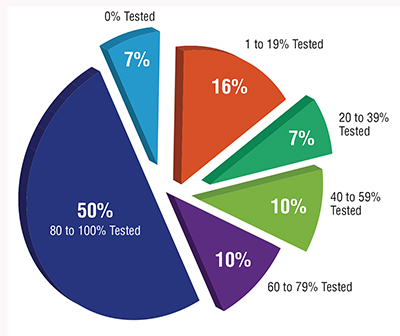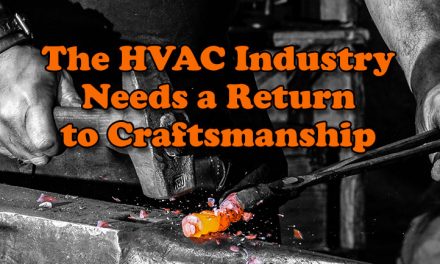
Mike Weil
There’s a growing voice in the HVAC Industry. It’s a voice of thousands of contractors committed to providing the comfort and efficiency they promise their customers every day.
While most contractors imply this promise, many unwittingly are not delivering on it. Not because they are bad tradesmen or have bad intent, but because as an industry, we’ve been taught that comfort improvements and high efficiency are attained by upgrading and changing out equipment.
Times are Changing
More than 25,000 professionals in 7,000-plus companies provide measured, verified performance on HVAC systems they install and service across the country. In other words, they prove to their customers daily that the systems they install and service deliver. We are talking about real comfort and efficiency delivered into the living space in a safe and healthy way.
Of these professionals, more than 14,000 subscribe to this magazine, High-Performance HVAC Today. They strive to provide customers with the highest level of quality and performance by testing every HVAC system they come in contact with.
Angel Morales of Russell’s Heating and Air Conditioning, Yucaipa, CA, is one such contractor. He says, ‘Since we’ve adopted the performance-based approach to contracting, we’ve seen sales improve tremendously. We test-in and test-out every system we install or renovate. We can prove our systems perform as we say they will.’

65% of respondents said they apply principles of? Performance-Based Contracting to their business.
Training Becomes Cultural
Michael Hyde, general manager of Hydes Air Conditioning in Palm Desert, CA, concurs. He says, ‘We are a Performance-Based Contactor, meaning not only do we follow the principles of performance, we believe in them.
‘And not just in the field. We train for performance in every facet of the business, including office work and management. We set goals, provide incentives, and pay well. As a result, we have very little staff turnover.’
Hyde also says that to do this properly requires continuous investment.
To back that up, High-Performance HVAC Today recently surveyed the Performance-Based Contractors’ who read this magazine. We found that 65% of them agree with Michael Hyde and say they are not only trained in the high-performance method, but they also train and work hard implementing the processes necessary to do this.
Endless Pursuit of Excellence
Jim Altman, president of Four Seasons Air Conditioning in Kingsville, TX says that training really is the key to his company’s success in the Performance-Based Contracting arena. ‘Our mission statement is, ‘The Endless Pursuit of Excellence,” he explains. ‘Training is the operative word here. It is through on-going training that we stand out and fulfill our customers’ expectations.
This contracting method is tantamount to a cultural revolution for many HVAC contractors. It involves implementing processes and training as well as a re-assessment of their typical business practices. And it requires a top-to-bottom commitment to change.

96% of Performance-Based Contractors invest in state-of-the-art tools, instruments and software.
This is an important distinction from traditional HVAC practices. Successful high-performance contractors include having internal and external training, holding regular meetings where goals are set and roadblocks discussed. They also equip technicians with the right tools and instruments necessary to properly test systems (both equipment and ductwork).
In fact, 96% of our survey respondents ‘ who are decision makers for their firms ‘ say they invest in state-of-the-art tools, instruments, and software to help them in their Performance-Based Contracting’ work.
Tool Ownership is Key
‘One of the things I learned is to have technicians do their own testing,’ adds Michael Hyde. ‘That means they must have their own tools and instruments. Each of our installation teams have their own flow hood along with basic tools like vacuum pumps, digital gauges, and even hot wire anemometers.
‘I like good tools, and we really help make sure our technicians have them,’ Hyde explains. He says his company provides technicians with a tool allowance.
The reason? They test nearly every HVAC system they encounter. He is not alone. Our study shows that 65% of respondent contractors apply the principles of Performance-Based Contracting’ to their businesses by conducting static pressure measurements and interpreting airflow on at least half their service and more than 60% of their installation calls. They do this to verify that each system is operating at optimum performance and efficiency. Then they can provide customers documented proof.

Percentage of HVAC installations tested for proper static pressure and airflow.
A Game of Balance
We also found that more than half of the contractors we surveyed balance the systems they work on at least 50% of the time, with nearly 40% balancing their installations 80 to 100% of the time. This means Performance-Based Contractors’ go well beyond their competitors when it comes to ensuring their customers? HVAC systems are operating as designed.
Says Michael Page of Air-Tech, Inc., Perris, CA, ‘Part of the culture change for us is to learn to balance the difference between what people want and what they can afford. Still as we move forward, we are adding profit to the company on jobs we would have otherwise not obtained.’
Page and other contractors we talk to say that it does take more time to conduct the testing and diagnosing, so they must reflect that in the cost of their services.
Kris Knochelmann, who owns Cincinnati, Ohio-based Schneller Heating and Air adds that by pricing things correctly he sees net profit contributions around 20% from Performance-Based Contracting.
He says, ‘This performance culture is about setting yourself up for more profitability and doing it the right way. And if you put all the pieces together the right way, you can package your company around that model and be successful for your customers, your team, and your family. That is a great legacy. It sets you apart from everybody else.’

Percentage of HVAC Systems serviced where static pressures were taken and airflow interpreted.
Don’t Try to Do Everything at Once
In the town of Newnan, GA, Progressive Heating and Air Corp. owner Greg Wallace sees implementing performance as a step-buy-step process that can time to put into place. In the last three years Progressive has made huge efforts to convert internal systems and processes to better manage the Performance-Based approach. Wallace says you have to go slowly so you don’t overwhelm your team.
With that in mind he recommends to start by having techs do simple static pressure tests on maintenance calls to get them used to doing it.
‘Doing that opened my technicians’ eyes,’ he says. ‘Add in training, both in-house and with organizations that focus on performance ‘ like the National Comfort Institute ‘ and our techs say a light bulb goes off in their heads. Now they know that HVAC is so much more than just pushing air through duct work. They know that customers deserve to receive the comfort and efficiency they were sold. And they want to deliver it!?
Don’t Go Overboard
Mike Hartman, president of Thomas E. Clark, Silver Spring MD, cautions that with selling High Performance, it’s important to not throw out the baby with the bath water.
‘I remember something Rob Falke said once in one of our classes. He said, ‘You can’t stop doing what makes you money.’ In other words, don’t jump into HVAC performance exclusively. If you’re a successful HVAC contractor, you’re probably making money selling equipment, and need to continue doing that. Just add duct renovation and air upgrade services on as menu items. I think that is very critical.’
The Performance-Based Contracting industry has been 25 years in the making. Today, thousands of HVAC contractors have made the transition and represent an industry within the overall HVAC industry.
Based on what these contractors are saying, Performance-Based Contracting provides them a leg up over competitors. Plus, they get paid a premium for providing a service consumers cannot get anywhere else.












Recent Comments